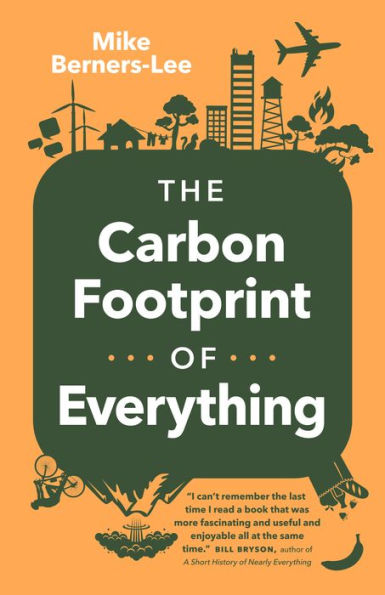

Paperback(2nd ed.)
-
PICK UP IN STORECheck Availability at Nearby Stores
Available within 2 business hours
Related collections and offers
Overview
Reduce your carbon footprint and understand the issue with this “up-to-date life guide for carbon-conscious readers.”—Kirkus
- Calculate your carbon footprint: with an item-by-item breakdown.
- Meet your company’s carbon goals: using the latest research.
- Covid-19 and the carbon battle: understand the new global supply chain.
The Carbon Footprint of Everything breaks items down by the amount of carbon they produce, creating a calorie guide for the carbon-conscious. With engaging writing, leading carbon expert Mike Berners-Lee shares new carbon calculations based on recent research. He considers the impact of the pandemic on the carbon battle—especially the embattled global supply chain—and adds items we didn’t consider a decade ago, like bitcoin and other cryptocurrencies.
Supported by solid research, cross-referenced with other expert sources, illustrated with easy-to-follow charts and graphs, and written with Berners-Lee’s trademark sense of humor, The Carbon Footprint of Everything should be on everyone’s bookshelf.
The Carbon Footprint of Everything is an extensively revised and updated edition of How Bad Are Bananas.

Product Details
| ISBN-13: | 9781771645768 |
|---|---|
| Publisher: | Greystone Books |
| Publication date: | 04/19/2022 |
| Edition description: | 2nd ed. |
| Pages: | 312 |
| Sales rank: | 664,131 |
| Product dimensions: | 5.40(w) x 8.40(h) x 0.90(d) |
| Lexile: | 1250L (what's this?) |
About the Author
Table of Contents
Introduction 1
A brief guide to carbon footprints 6
Less than 10 grams
A pint(16 oz) of tap water 16
An email 17
A Google search 20
A text message 21
A plastic grocery bag 22
Drying your hands 23
10 to 100 grams
A paper bag 25
Ironing a shirt 26
A Zoom call 27
A 100 g (3 oz) serving of carrots 28
An apple 29
A mile by electric bike 30
Walking through a door 32
Boiling a liter (a quart) of water 33
Traveling a mile by bus 35
Cycling a mile 36
100 to 500 grams (3.5 to 17.5 oz)
A 200 g (7 oz) serving of boiled potatoes 38
A banana 40
A diaper 41
An orange 42
A supermarket delivery 43
Traveling a mile by train 45
An hour watching TV 47
A shower 50
A unit of heat 51
A letter (and other mail) 53
A unit of electricity 55
A newspaper 57
A liter (32 oz) bottle of water 59
A bowl of oatmeal 60
A roll of toilet paper 61
Washing dishes 62
A 250 g (8 oz) clamshell of strawberries 64
500 grams to 1 kilo (1.1 to 2.2 pounds)
An ice cream or popsicle 66
Driving a mile 67
A latte (or a tea or coffee) 69
1 kg (2.2 lbs) of trash to landfill 71
A loaf of bread 73
A pint (16 oz) of beer 74
A 10-inch pizza 76
A 200 g (7 oz) serving of fish 78
Spending $1 79
A paperback book 80
Taking a bath 82
1 to 10 kilos (2.2 to 22 pounds)
A pint (16 oz) of milk 83
A 250 g (8 oz) bunch of asparagus 86
A bottle of wine 87
A bunch of flowers 89
A carton of eggs 91
A day's protein (50 g/2 oz) 93
A load of laundry 96
Desalinating 1,000 liters (264 gallons) of water 97
250 g (8 oz) of cheese 99
A 125 g (4 oz) burger 101
1 kg (2.2 lbs) of rice 103
A takeout taco 105
1 kg (2.2 lbs) of plastic 106
1 kg (2.2 lbs) of tomatoes 108
A 250 g (8 oz) steak 109
10 to 100 kilos (22 to 220 pounds)
A pair of shoes 111
A pair of pants 112
A rush-hour car commute 114
A bag of cement (25 kg/55 lbs) 115
Leaving the lights on 117
A night in a hotel 118
A leg of lamb (2 kg/4.4 lbs) 120
A week's food shopping 122
New York City to Niagara Falls and back 124
Using a smartphone 126
100 to 1,000 kilos (220 pounds to 1 ton)
A 50-liter (13-gallon) tank of gas 129
A necklace 131
Christmas excess 132
A new carpet 135
Insulating an attic 136
A funeral 138
A computer (and using it) 140
A pet 142
A mortgage 144
1 to 10 tons
An operation 146
A ton of steel 148
A ton of nitrogen fertilizer 150
Flying from Los Angeles to Barcelona return 152
Solar panels 154
10 to 1,000 tons
A new car 157
A person (annual footprint) 161
Space tourism and travel 163
A wind turbine 165
A new-build house 167
A car crash 170
Having a child 171
Millions of tons
A volcano 174
The World Cup (soccer) 175
A new coal mine 176
Cryptocurrencies 178
The Cloud and the world's data centers 179
The USA (and other countries) 181
Billions of tons
Wildfires 185
The world's IT 187
A war 190
Deforestation 191
Black carbon 193
The world's annual emissions 194
Burning the world's fossil-fuel reserves 197
Negative emissions
Planting trees 202
Marine planting 203
Soil carbon sequestration 204
Biochar 204
BECCS (bioenergy with carbon capture and storage) 205
Enhanced rock weathering 206
DACCS (direct air capture and carbon storage) 207
What can we do? 209
Where the numbers come from 232
Appendix: Calculating footprints 238
Notes and references 244
Thanks 287
Index 290
